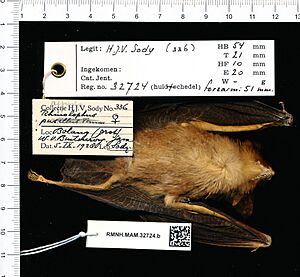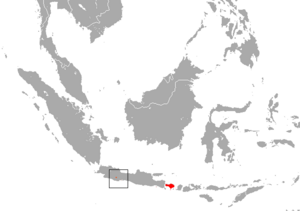Canut's horseshoe bat facts for kids
Quick facts for kids Canut's horseshoe bat |
|
|---|---|
 |
|
| Conservation status | |
| Scientific classification | |
| Genus: |
Rhinolophus
|
| Species: |
canuti
|
 |
|
| Canut's horseshoe bat range | |
The Canut's horseshoe bat (Rhinolophus canuti) is a special type of bat that belongs to the Rhinolophidae family. This bat is found only in Indonesia, meaning it is endemic to that country. It's known for its unique nose shape, which looks a bit like a horseshoe!
Contents
Discovering the Canut's Horseshoe Bat
This interesting bat was first officially described as a new species in 1909. The scientists who discovered it were Oldfield Thomas and Robert Charles Wroughton. They decided to name the bat "canuti" to honor a Danish scientist named Knud Andersen. The name "Canute" is an English version of "Knud." Thomas and Wroughton chose to honor Andersen because of his amazing and detailed work on the complex group of Rhinolophus bats.
What Does the Canut's Horseshoe Bat Look Like?
The Canut's horseshoe bat has some unique features. Its head and body are about 65 millimeters (about 2.5 inches) long. Its tail is shorter, around 22 millimeters (less than an inch). Its ears are quite large, measuring about 24 millimeters (almost an inch). A special part of its skull, called a rostral projection, sticks out on top. This bat also has a very thin connection between two parts of its nose leaf, which are called the sella and the posterior lancet.
Life and Habits of the Canut's Horseshoe Bat
Canut's horseshoe bats are insectivores, which means they love to eat insects! They are also nocturnal, so they are active at night. During the day, they rest and sleep in safe, sheltered spots like caves. These bats likely live in large groups, forming colonies with many other bats. This helps them stay safe and warm.
Where Do Canut's Horseshoe Bats Live?
You can find the Canut's horseshoe bat on two islands in Indonesia: Bali and Java. These islands provide the perfect habitat for them to live and find food.
Protecting the Canut's Horseshoe Bat
Currently, the IUCN (International Union for Conservation of Nature) lists the Canut's horseshoe bat as a vulnerable species. This means that its population is thought to be shrinking, and it needs our help to survive. Protecting their homes and food sources is very important to make sure these unique bats continue to thrive.


